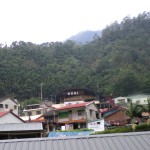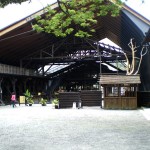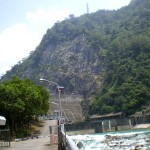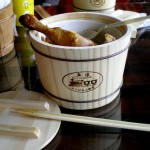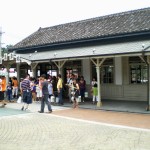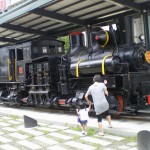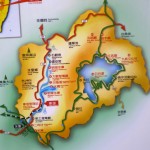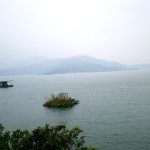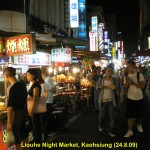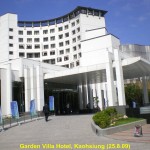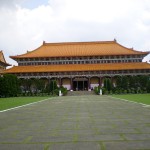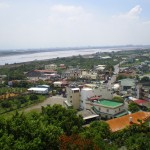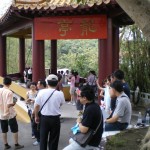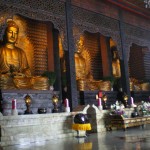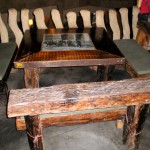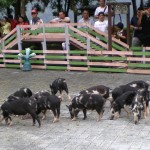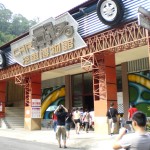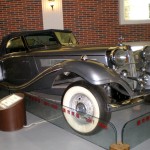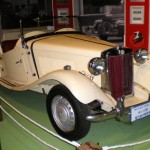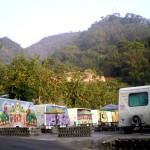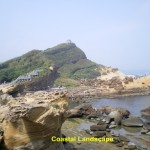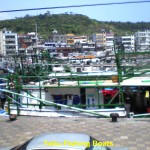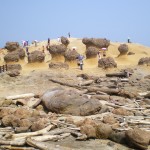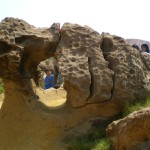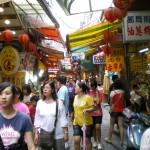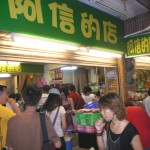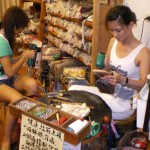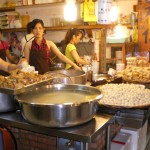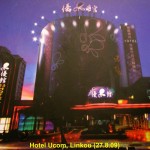Taiwan Travel II
(Continued from Taiwan Travel I)
Day 3 : 24 August 2009
Checheng, Nantou County
Checheng is a small quiet village located in a mountainous area of Shueili in Nantou County of Central Taiwan. It has gone through a few times of prosperity and hardship during the last 100 years.
In 1913, Checheng was thriving when a railway line for manually operated railway carts was built to transport cane sugar from the village to Puli. Undoubtedly, it soon became the villagers’ main means of transport. A workshop for railway carts and residential place for the railway-workers were established here making it a busy village.
As Checheng had those railway carts, it was given the name “Checheng” which, literally, means “square cart”.
Checheng became more prosperous, when the Daguan Hydroelectric Power Plant was being constructed nearby in 1919, and another cart railway was built from Ershuei to the village in 1922. But in 1934 when the power station was completed, the dam-workers left the village and it suffered economic hardship.
In 1958, Checheng’s prosperity came back again when timber factories were established there. Later, in 1985, it suffered economically again, when the Taiwan government banned logging.
Then, in the early 1990s, Checheng became a thriving village once more when two dams, Minghu and Mingtan, were constructed across the Shueili River in the north. But when they were completed in 1995 the village experienced an economic downturn again. Since then it remained a ghost town until 2001 when the Checheng Tourism Board decided to make it a tourist attraction.
Today, the legacy of the logging era can be seen in Checheng. A large, old sawmill is now a museum which houses some of the sawmill relics and provides valuable information about the history of the village.
Near the museum vistors can see a large log storage pool where logs were kept temporarily, a crane for lifting logs off lorries and lowering them into the pool, and a workshop where manually operated railway carts were repaired.
There are two railway carts at the workshop and visitors may try to operate them manually for a short joy ride. Some of the relics of the steam-engined locomotives are still around at Checheng, such as standpipes, coal-adding platforms and water-tanks. The whole of Checheng is in fact a museum showcasing its economic and cultural history.
When we arrived at Checheng, we were famished and went straight to a small restaurant, Cedar Tea House, where we had a small wooden barrel of delicious chicken rice for lunch (Bento lunch). After the meal we were asked to keep the containers as a souvenir which we gladly did. Then we began to tour the little, quiet, quaint village.
Having spent more than an hour at the village, we walked a short distance to a small old railway station. Then we boarded a modern diesel-engined train and travelled to Jiji to experience several kilometres of train-ride. When we arrived at Jiji, we noticed that there was a remarkable contrast between Jiji and Checheng: Jiji is a large busy town.
Built in 1933, Jiji’s wooden railway station is the oldest in Taiwan. There is a train museum which is a stone throw from the station. It showcases the cultural relics of Jiji retracing the history of the railway line. Besides, an old steam-engined train can be seen standing proudly outside the museum.
On arrival at the Jiji railway station, we boarded our buses and left for the Sun Moon Lake which is not far from Checheng.
Sun Moon Lake, Nantou County
Surrounded by the mountains in Nantou County in Central Taiwan, Sun Moon Lake is the largest lake in Taiwan and it is 760 metres above sea-level. It is so called because the eastern part of the lake is round and looks like the shape of the sun whereas the western part looks like the shape of a crescent moon.
It is a picturesque, romantic lake with tranquil water, and surrounded by awesome mountains. To enjoy its natural beauty, visitors may take a stroll, cycle, or row a rented boat round it. To see the whole lake fast, they may board a boat that cruises round it.
The first people to settle at the lake were the Thao aborigines. Later, they were joined by the Han Chinese of the Qing Dynasty who built some temples at the lake, such as Syuanguang Temple, Syuanzang Temple, Wunun Temple and Choh Pagoda.
A hydroelectric power station which was built by the Japanese during their occupation makes use of the water from the lake.
On arrival at the lake, we went to a spot where we had a good view of the misty large lake. Having enjoyed the beautiful sight of the lake and the surrounding mountains, we left for Kaohsiung, Taiwan’s second largest city, in the south.
After three hours of travelling, we reached Kaohsiung City in the evening. We went to the largest mall in the city first, Dream Mall, and then the most popular night market in Taiwan, Liouhe Night Market, in the centre of the city to have dinner.
Liouhe Night Market in Kaohsiung City
In the evening from 6 p.m. to 2 a.m. part of the Liouhe 2nd. Road between Zihli Road and Jhongshan Road is closed for the Liouhe Night Market. Over 150 stalls are set up on both sides of the road selling cheap and mouth-watering food such as stinking ‘tofu’, grilled squids and fish, large meatballs, fried oyster omelette, squid soup, cooked chicken feet, eel noodle, and many more. It is a street food paradise for both locals and tourists alike.
VIPs: The Liouhe Night Market boasts of visits by VIPs, such as presidents, well-known overseas movie stars,
entertainers and other very important persons. Visitors may visit a tourist information centre and public toilets located next to the Jiangua Elementary School near the crossroads of Zihli Road and Liouhe 2nd. Road.
According to the 2008 survey conducted by the Taiwan Tourism, Transportation & Communication Ministry, this night market is the most popular one on the island.
Having enjoyed the sights, sounds and the roadside food of the night market, we left for the Garden Villa Hotel which is new and looks like a white, grand palace built in a modern architechural style. We stayed at the hotel, comfortably, for a night, and in the morning we left for Fo Guang Shan Monastery.
Day 4 : 25 August 2009
Fo Guang Shan Monastery, Kaohsiung County
Fo Guang Shang Monastery is the largest Buddhist monastery in Taiwan. Located in the Dashu Township in Kaohsiung County, it was founded by Master Hsing Yun in 1967. It is established with the following objectives:
*To propagate Buddhist teachings through cultural activities
*To foster talent through education
*To benefit society through charitable programs
*To purify hearts and minds through Buddhist practice
It has affiliated branch temples and organizations all over the world. It offers many activities for anybody regardless of his /her religion, race and greed, such as morning prayer, calligraphy, meditaion, Tai Chi, etc.
This monastery is built on a hill overlooking a village and flood plain where a meandering river flows. In its compound, there are several buildings for different functions, such as meditation, worship, its history exhibition(mini-museum), pilgrim accommodation, monk and nun accommodation, Buddha’s tooth relic, etc.
The most prominent feature in the monastery is a 36-metre high statue of Buddha surrounded by many identical but small ones.
We spent more than an hour touring the whole place. We felt it was quite an impressive and great monastery. Then we had lunch at a restaurant at the foot of the hill before we left for Taichung City in the north.
Taichung City
It was a long journey to Taichung City. We arrived at the city of 1.1 million people in the evening and went straight to a unique restaurant, Five Cent Driftwood Restaurant, for dinner.
The Five Cent Driftwood Restaurant, Taichung City
The owner of this restaurant in Taichung is an ambitious, artistic and enterprising lady, Hsieh Li-shiang. When she was 8 years old, she built a tree house which later gave her the inspiration to build five restaurants in Taiwan in her own unique architectural designs.
She used driftwood, trees, coloured bricks, oyster shells, rocks, sculpture, and other things she fancies as decorations for her restaurants. Besides, the tables, benches, plates, cups, bowls, etc. in all her restaurants are all designed by herself.
Hsieh Li-shiang’s restaurants are well-known in many countries, as Taiwanese tour guides like to bring foreign tourists to her restaurants to see for themselves her unusual architecture and sculpture, besides her delicious cuisine.
When we were inside the dimly-lit Five Cent Driftwood Restaurant in Taichung City, we admired the lady’s unusual works of art. Then we sat on the low benches close to the square tables, both made of driftwood and designed by the lady, and enjoyed the simple but tasty food.
Having taken our dinner at the restaurant, we headed for a night market in Taichung Downtown known as Feng Chia Night Market.
Feng Chia Night Market, Taichung City

Feng Chia Night Market was first opened along Wen-hua Road in 1963. As it gained popularity, it expanded to Feng Chia Road, Fusing Road, Xian Road and other roads. It is a favourite place for shoppers and food lovers.
Shops along these roads sell a wide range of goods ranging from clothes to modern electronic gadgets, and over a hundred street vendors offer many kinds of local snacks. As there is a university nearby (Feng Chia University), the market is also a favourite haunt of the students.
We spent an hour at the market savouring a variety of local snacks and shopping for some clothes along the busy Fusing Road before we travelled again to the Miaoli County in the north. In the late evening, we arrived at a hotel, West Lake Hotel in Sanyi, Miaoli County, where we tried to get as much sleep as possible.
Day 5 : 26 August 2009
West Lake Hotel, Sanyi, Miaoli County
This hotel, located in a quiet countryside, has a beautiful romantic garden of European style. It has a fountain in the centre and a row of ancient European statutes, like Venus de Milo, David, Winged Angels, etc. Besides, it has an amusement park known as Cartoon Dream World suitable for children.
The forests that surround the hotel area provide a natural place for studying the flora and fauna, and trekking for the adventurous. This resort is ideal for families considering the fun and educational activities available here.
In the morning, after breakfast, my wife and I went to the garden admiring its charm and beauty, and enjoying the freshness of the air.
Later, we left the hotel and travelled north-east for an hour to the Fantasy World Resort in Hsinchu County.
Fantasy World Resort
On arrival at the Fantasy World Resort which is in the mountainous area, we were invited to a fun-filled parrot show in which a few colourful, friendly and intelligent parrots did some interesting and amazing acts, like two parrots racing up the flagstaffs, a parrot cycling on a thin rope, an intelligent parrot picking the right coloured ball and paper money in one of the three inverted cups, etc.
Then we watched tame and beautiful pheasants flying down a hill. Later, we laughed and cheered as we watched 11 little pigs competing with each other in a challenging obstacle race.
Before the piggy race, we were asked to bet on the pig that would win a 40-metre race. Unfortunately, I bet on the wrong one and failed to get a prize which was a large cute-looking piggy bank
After the three animal shows, we visited the Car Museum which housed vintage cars made since 1912. Some of the photos below show the beautiful cars in the museum:
At night we retired not in a hotel but caravans in the open in the Fantasy World Resort. It was my first and memorable experience sleeping with my wife in a caravan under the starry sky far away from the hustle and bustle of the Hsinchu City.
In the morning we left the resort and travelled a long journey to a coastal place in the north known as Yehliu.
Yehliu, Taipei County
Yehliu is a small fishing town in the north of Taiwan. Its main attraction is the unusual landscape on the long narrow piece of land that juts 1700 metres into the sea (headland). It is known as “Yehliu GeoPark“.
This land was submerged 4000 years ago in the sea and consisted of sandstone, coral limestone, shale and other rocks. It was raised slowly at the rate of 2 to 4 millimetres per year, and was constantly subjected to erosion by waves, currents, tides and sea-water for millions of years.
The erosive work of these active agents had produced many kinds of shapes and sizes of rocks that are now dominating the coastal landscape.
The rocks are named after common things which look like them, such as “pot-holes“, “mushrooms“, “honeycombs“, “ginger“, “candles“, “beancurds“, “fairy’s shoe” and “chessboard“. Among them, the “mushrooms” totaling about 180 are the most striking ones.
There is one which looks like a queen’s head. Some rocks with exposed sea-animal and plant fossils can be seen here.
In the middle of the headland stands a statue of a man, Lin Tien-chen. In 1964, when he saw a student being swept away by a large wave, he quickly jumped into the sea and tried to save him. Unfortunately, he failed and lost his life. The student died too. In memory of that courageous man, a statue of him is erected there.
We spent two hours at the Yehliu Geo Park and saw a lot of the physical wonders scuptured by Nature. Then we left for Jioufen to visit a well-known old street in the east of Yehliu.
Jioufen Old Street, Taipei County
Jioufen is an old village in a lush green mountainous area in northern Taiwan. As it is sited on a high mountain it offers a spectacular view of the mountains (e.g. Keelung Mountain), valleys and coastal areas. It was once a prosperous gold and coal mining settlement.
Besides its awesome scenery, Jioufen has a famous old street that attracts hundreds of tourists both local and foreign alike every day. It is a long street that is lined with over a hundred shops that sell many kinds of local food, snacks, hand-made wooden clogs, apparels, toys, souvenirs and many more. As the street is narrow and crowded, tourists have to zigzag their way or they may be bulldozed by others.
When my wife and I were in the Jioufen Old Street, we bought a lot of local snacks from a popular shop recommended by our tour-guide, Tracy, to bring home and give away as presents. After that, we looked for a crowded food shop which we thought would serve delicious food. We found one and enjoyed the food.
Later, we left Jioufen for Taipei City. On arrival at the city, we visited the Taiwan’s most famous museum, the National Museum Palace.
National Museum Palace, Taipei City
Located in the Wai Shuangxi area of Shilin on the outskirts of Taipei City, the National Palace Museum showcases over 650,000 priceless relics of Chinese ancient civilisations of Song, Yuan, Ming and Qing dynasties, rituals, beliefs, etc. dating back to 8000 years.
These treasures were brought in from Mainland China to Taiwan by the Nationalist Government in 1949 when it lost the civil war to the Communist Party there. In 1965 these treasures were brought to the National Palace Museum and since then it is open to the public.
The first three floors of the museum are used for exhibiting the relics. Each floor displays more than a theme. Below are some of the themes of the exhibits in the museum:
1. Painting and Calligraphy on the 2nd. Floor
2. Rare Books an Historical Documents on the 1st. Floor of the West Wing
3. Antiquities:
a. Permanent Exhibitions: “The Treasures of 8000 Years” on the 2nd. and 3rd. Floors of the East Wing
b. Themed Permanent Exhibitions on the 1st. and 3rd. Floors
c. Special Exhibitions on the 3rd. Floor of the West Wing
4. Others:
The 1st. Floor of the East Wing is the venue for joint special exhibitions of painting and calligraphy,
antiquities and rare books and historical documentaries, or of modern painting and calligraphy.
As we did not have much time to see all the exhibits in the museum, our smart Taiwanese tour guide, Tracy Tu, brought us to see some of the important items only and related the interesting histories connected to them. We found that the museum was an excellent place to learn about the China’s last 8,000 years of history.
When it was dinner-time, we left the museum for a very popular night market in the downtown, Xi Men Ding Night Market.
Xi Men Ding Night Market, Taipei City
Xi Men Ding Night Market is in Wanhua District in Taipei. It is a well-known place for shopping, entertainment, and local and exotic cuisine. It is always crowded with people from all walks of life, foreign and domestic alike.
Besides, there are buskers on walkways showing off their talents to large crowds. While walking in the crowded night market, we felt as though the place was having a carnival: shops were brightly lit, sales-workers with microphones calling for people to patronise their shops and holding large, colourful billboards that announced

Ah Chong Flour-Rice Noodle Shop(1975)delicious food and attractive discounts for products, frequent influxes of visitors, shops busy serving customers, etc. Then we stopped at a food shop where many people were queueing up. Our tour guide who was near us recommended that we should try the noodle food from that shop. The shop was known as “Ah Chong Flour-Rice Noodle Shop”. When we had bought the food we were surprised that the shop did not provide chairs and tables for the customers. So all of us had to stand or squat on the walkway and enjoyed the hot, delicious noodle.
delicious food and attractive discounts for products, frequent influxes of visitors, shops busy serving customers, etc.
Then we stopped at a food shop where many people were queueing up. Our tour guide who was near us recommended that we should try the noodle food from that shop. The shop was known as “Ah Chong Flour-Rice Noodle Shop”.
When we had bought the food we were surprised that the shop did not provide chairs and tables for the customers. So all of us had to stand or squat on the walkway and enjoyed the hot, delicious noodle.
U.Com Hotel, Linkou County
After an enjoyable experience at the night market, we left for Linkou County where we checked in a hotel known as U.Com Hotel.
This hotel is an awesome one. Every quest-room has a car-park outside regardless on which floor. For an example, if a quest’s room is on the 7h. floor, he can drive his car right up the hotel to his car-park next to his room!
Day 7 : 28 August 2009
Early in the morming on the last day of our tour, with the packed breakfast from the hotel, we left for the Taoyuan International Airport.
On arrival at the airport, we thanked and bade farewell to our diligent, helpful, friendly and responsible Taiwanese tour-guides, Tracy Tu and Leong, and the two skilful bus-drivers, Sia and Lim, who had done a good job in transporting us safely for the unforgettable 7-day Taiwan tour. At about 8.20 a.m. the China Airline took off and flew us back to Malaysia, our home.
This is another travel story of mine and I hope you have enjoyed reading it.
Written by: Choo Chaw, Kluang, Johor, Malaysia.

